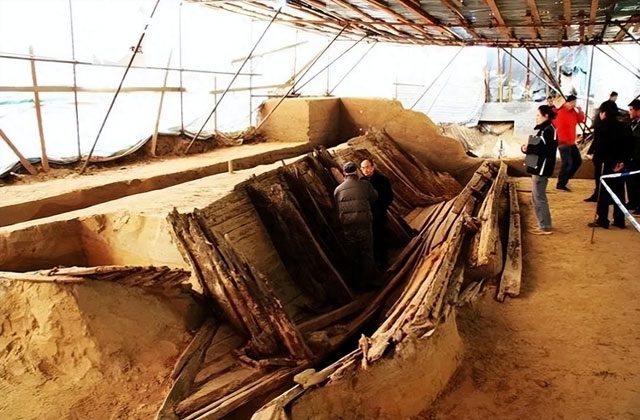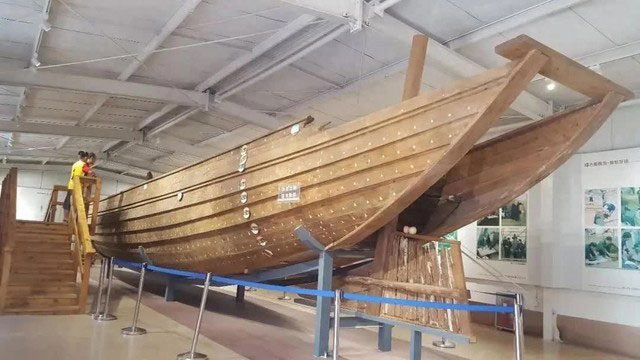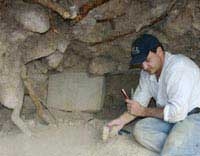The value of the artifacts on this ship cannot be quantified in monetary terms due to their immense quantity.
On September 7, 2019, Haizha, Shandong Province, China, experienced heavy rainfall. The central area of Haizha was the most severely affected by the storm. In this area, construction of a new public facility had just begun. Due to the heavy rain, soil and various items were washed away. While excavating and clearing the construction site, the workers discovered numerous pieces of blue porcelain emerging from the ground.
Immediately, they reported this to the site management. Upon assessing the situation, the manager determined that these were not ordinary porcelain shards. He promptly called the police.
While waiting for the authorities to arrive, the workers unearthed a relatively intact porcelain vase. When the officer saw this vase, he immediately requested a lockdown of the entire construction site. At the same time, they contacted the local cultural heritage protection agency to investigate.
Initially, upon hearing about the discovery of the ancient vase, the authorities believed this could be a burial site. However, when the cultural heritage inspection team began their work, they found signs indicating that what lay beneath the ground was not an ancient tomb. Instead, experts theorized that this could be a shipwreck carrying artifacts that had been buried.

Heavy rain reveals shipwreck carrying artifacts.
As excavation continued deeper, the remains of the ship gradually became visible. Subsequently, specialists began to clean the outer structure of the ship. They speculated that this was a wooden cargo ship. The entire left side of the ship’s frame was missing, while the bottom remained largely intact. The ship was tilted at a 50-degree angle. They suspected that it had sunk due to a collision.
This discovery of a sunken ship is extremely rare. To protect the integrity of the ship’s hull and the items in the cabin from damage, the heritage department invited the two best traditional shipbuilders in the area to provide guidance.

Excavation of an ancient shipwreck is a rare event.
In fact, inviting these two master craftsmen to the site was not a simple task. They were both born into families with a tradition of shipbuilding dating back to the Ming Dynasty. At that time, these two veteran craftsmen still possessed ancient ship models from centuries ago.
However, upon receiving news of the discovery of a sunken ancient ship, the two did not decline the invitation and immediately participated in the support. They were invited to the site to analyze the overall structure of the ship, as well as the function of each cabin. This would help experts understand which parts of the ship were the weakest and the hardest to clean. Consequently, the excavation proceeded smoothly.
Both the archaeologists and these two master craftsmen agreed that excavating a sunken ancient ship is exceedingly rare, with very few large ships extending up to 50 meters like this one.

Experts predict this ship dates back to the Yuan Dynasty. (Illustrative image).
Throughout the excavation and cleaning process, the local cultural heritage protection bureau discovered many ancient coins. Based on this evidence, combined with the structural characteristics of the ship, experts predict it dates back to the Yuan Dynasty.
They also confirmed the archaeological and economic value of the ship is immense. More than 120 intact artifacts have been excavated from within the ship. Notably, these are all porcelain items produced during the Yuan Dynasty – an extremely valuable type of porcelain. Despite being buried for many years, the patterns and designs remain sharp and clear.
In 2005, the Goston auction house in London successfully auctioned a blue-and-white porcelain vase from the Yuan Dynasty for a hidden bidder at a price of £15.688 million (approximately 497 billion dong). After the sale of this vase, many people eagerly sought blue-and-white porcelain items from the Yuan Dynasty.
The blue-and-white porcelain of the Yuan Dynasty is valuable because these products cannot be replicated.
This is enough to illustrate the immense value of this ship, which contains over 120 artifacts originating from the Yuan Dynasty.
Throughout the research process, archaeologists eventually uncovered the reason for the ship’s sinking. They theorized that a strong current may have forced the ship to alter its original route, leading to an incident that caused it to sink.
After cleaning and restoration, the ship is displayed in the Haizha Museum. Many shipbuilding artisans have come here to admire and study the shipbuilding techniques from the Yuan Dynasty. Although the overall shape of the ship is not as refined as it is now, the joining techniques leave modern shipbuilders in awe.





















































